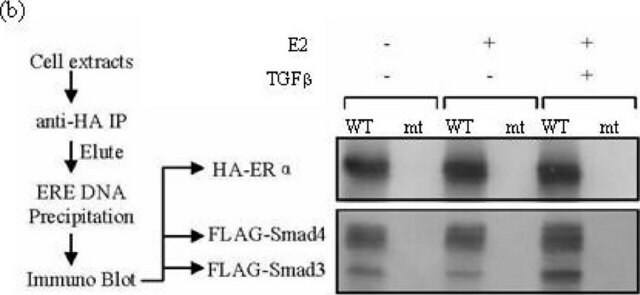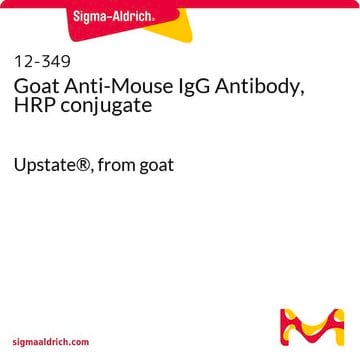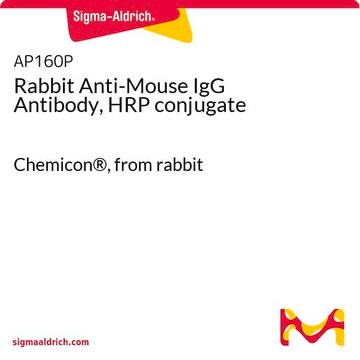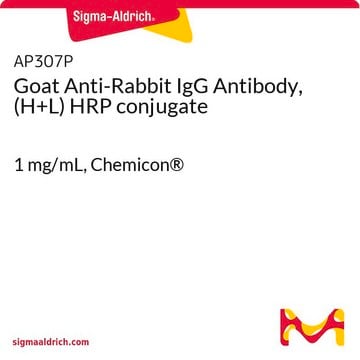SAB3701083
Anti-Mouse IgG (H+L)-Peroxidase antibody produced in rabbit
affinity isolated antibody, lyophilized powder
Synonyme(s) :
HRP
Se connecterpour consulter vos tarifs contractuels et ceux de votre entreprise/organisme
About This Item
Code UNSPSC :
12352203
Nomenclature NACRES :
NA.46
Produits recommandés
Source biologique
rabbit
Niveau de qualité
Conjugué
peroxidase conjugate
Forme d'anticorps
affinity isolated antibody
Type de produit anticorps
secondary antibodies
Clone
polyclonal
Forme
lyophilized powder
Espèces réactives
mouse
Technique(s)
immunohistochemistry: suitable
indirect ELISA: suitable
western blot: suitable
Conditions d'expédition
wet ice
Température de stockage
2-8°C
Modification post-traductionnelle de la cible
unmodified
Description générale
Immunoglobulin G (IgG) belongs to the immunoglobulin family and is a widely expressed serum antibody. It consists of a γ heavy chain in the constant (C) region. The monomeric 150kDa structure of IgG constitutes two identical heavy chains and two identical light chains with molecular weight of 50kDa and 25kDa, respectively. The primary structure of this antibody also contains disulfide bonds involved in linking the two heavy chains, linking the heavy and light chains and resides inside the chains. IgG is further subdivided into four classes namely, IgG1, IgG2, IgG3, and IgG4 with different heavy chains, named γ1, γ2, γ3, and γ4, respectively. Limited digestion using papain cleaves the antibody into three fragments, two of which are identical (called Fab fragments) and contain the antigen-binding activity. The third fragment (called Fc fragment) does not possess antigen-binding activity, but binds to cells and effector molecules. Pepsin cleaves the carboxy-terminal side of the disulfide bonds in the general region of the antibody and this gives rise to the F(ab′)2 fragment. The two antigen-binding arms of the antibody are linked in this fragment. Maternal IgG is the only antibody transported across the placenta to the fetus. It passively immunizes the infants.
Spécificité
This product was prepared from monospecific antiserum by immunoaffinity chromatography using Mouse IgG coupled to agarose beads. Assay by immunoelectrophoresis resulted in a single precipitin arc against Anti-Peroxidase, Anti-Rabbit Serum, Mouse IgG and Mouse Serum.
Immunogène
Mouse IgG whole molecule
Propriétés physiques
Antibody format: IgG
Forme physique
Supplied in 0.02 M Potassium Phosphate, 0.15 M Sodium Chloride, pH 7.2 with 10 mg/mL Bovine Serum Albumin (BSA) - Immunoglobulin and Protease free
Reconstitution
Reconstitute with 1.0 mL deionized water (or equivalent).
Clause de non-responsabilité
Unless otherwise stated in our catalog or other company documentation accompanying the product(s), our products are intended for research use only and are not to be used for any other purpose, which includes but is not limited to, unauthorized commercial uses, in vitro diagnostic uses, ex vivo or in vivo therapeutic uses or any type of consumption or application to humans or animals.
Vous ne trouvez pas le bon produit ?
Essayez notre Outil de sélection de produits.
Faites votre choix parmi les versions les plus récentes :
Déjà en possession de ce produit ?
Retrouvez la documentation relative aux produits que vous avez récemment achetés dans la Bibliothèque de documents.
Les clients ont également consulté
Alaín González Pose et al.
Journal of veterinary research, 65(1), 27-37 (2021-04-06)
Proper conformational arrangement of the E2 molecules of bovine viral diarrhoea-mucosal disease virus (BVD-MDV) is crucial to obtain an effective recombinant vaccine candidate against the disease. In this study, we characterised a new molecule composed of two distinct sequences of
Human placental Fc receptors and the transmission of antibodies from mother to fetus.
Simister NE and Story CM
Journal of Reproductive Immunology, 37(1), 1-23 (1997)
Antibody structure, instability, and formulation.
Wang W
Journal of Pharmaceutical Sciences, 96(1), 1-26 (2007)
Notre équipe de scientifiques dispose d'une expérience dans tous les secteurs de la recherche, notamment en sciences de la vie, science des matériaux, synthèse chimique, chromatographie, analyse et dans de nombreux autres domaines..
Contacter notre Service technique










